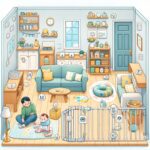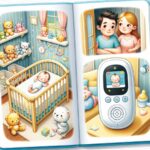How to baby-proof your home effectively against electrical hazards is a critical question that every parent needs to address to ensure the safety of their little explorers. From the moment they start crawling, babies are driven by curiosity to explore every nook and cranny, often leading them towards potential dangers, especially electrical outlets and cords. This article aims to guide you through the process of safeguarding your home from electrical risks, ensuring a safe environment for your precious bundle of joy.
Understanding the Risks: Electrical Hazards in Your Home
Before diving into the how-tos, it’s essential to understand what makes electrical components dangerous to babies and toddlers. Electrical outlets, cords, and appliances can pose serious risks if not properly managed. These risks include electric shock, burns, and even the potential for electrical fires. Babies and young children are especially vulnerable due to their smaller body size and their natural curiosity to touch and taste everything.
Securing your home involves more than just covering outlets. It requires a comprehensive approach to evaluate and mitigate all potential electrical hazards. This could range from securing loose cords to ensuring appliances are out of reach. Recognizing the common household hazards for babies and how to childproof against them is the first step towards creating a safer home.
How to Baby-Proof Your Home Effectively Against Electrical Hazards
Now, let’s focus on the practical steps to baby-proof your home effectively against electrical hazards. The key is to anticipate what might attract your baby’s attention and secure it before it becomes a problem. Here are some strategies to consider:
- Use outlet covers for all unused electrical outlets. Opt for covers that are difficult for little fingers to remove but easy for adults to operate when needed.
- Secure and hide electrical cords away from baby’s reach. This can be achieved by using cord shorteners, cord covers, or by rearranging furniture to keep cords hidden.
- Ensure all appliances are safely out of reach or securely anchored to prevent tipping. Pay special attention to items like lamps, which can be pulled down by a curious child.
- Consider the use of wireless or battery-operated devices when possible to reduce the risk of cord-related hazards.
For additional safety, look into the latest technological advancements in childproofing, such as tamper-resistant receptacles, which prevent objects from being inserted into an outlet unless they are being plugged in properly. This is a highly recommended upgrade for homes with young children. For more information, consult the National Fire Protection Association’s guidelines on electrical safety.
Implementing these strategies not only secures your home but also teaches your children the importance of electrical safety as they grow. Regularly inspect your home for potential electrical hazards and never underestimate the curiosity of a child. Remember, effective baby-proofing is an ongoing process that evolves with your child’s development stages.
Additional Resources for a Safe Baby-Proofed Home
Baby-proofing against electrical hazards is just one aspect of creating a safe environment for your children. There are numerous resources available to help you navigate the complexities of childproofing your home. Here are some valuable links from our internal library that can provide additional insights and tips:
- Common Household Hazards for Babies and How to Childproof
- Essential First Aid Skills Every Parent Should Know
- Creating a Non-Toxic Nursery: Safe Materials and Products
- Baby-Proofing Your Home for a Crawling Infant
- Safe Sleep Practices to Reduce the Risk of SIDS
- Tips for Baby-Proofing Your Home Effectively
By combining these strategies with a proactive approach to baby-proofing, you can create a home environment that is not only safe from electrical hazards but also conducive to your baby’s growth and exploration. Remember, the key to effective baby-proofing is not just to protect but also to educate and prepare for the unpredictable nature of childhood curiosity.













